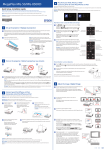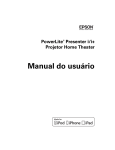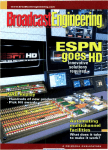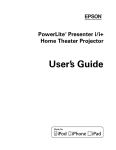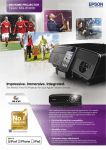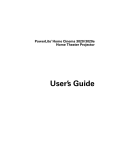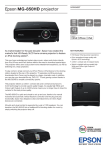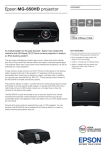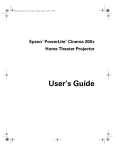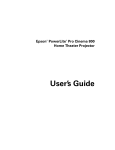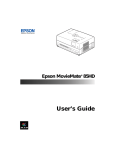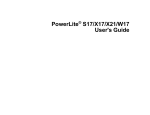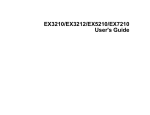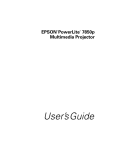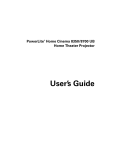Download MegaPlex MG-50 Epson Home Cinema Projector Manual
Transcript
MegaPlex MG-50/MG-850HD Home Theater Projector User’s Guide Contents Introduction Projector Parts Optional Accessories Registration and Warranty Using This Manual Setting Up the Projector Choosing a Location Installing the Projector Installing Batteries in the Remote Control Turning the Projector On and Off Turning On the Projector Turning Off the Projector Projecting From an iPod, iPhone, or iPad Connecting an iPod or iPhone Connecting an iPad Checking the Dock Light Removing Your iPod, iPhone, or iPad Device Playback Playing Video and Music From Your iPod, iPhone, or iPad Playing Music When the Projector Is in Standby Mode Controlling Playback Configuring the Screen Saver Projecting Photos, Videos and YouTube Videos From Your iPod, iPhone, or iPad Playing Music With Photos 2 Contents 5 6 10 10 11 12 12 15 17 17 17 18 19 19 20 21 22 23 23 24 24 25 25 26 Connecting Other Devices Connecting Video Equipment Connecting Computer Equipment Installing the USB Driver Connecting a Microphone Connecting a USB Storage Device Playing a Slideshow Customizing Slideshow Settings Making Basic Adjustments Positioning the Image Adjusting the Image Resizing the Image Focusing the Image Selecting the Image Source Choosing the Aspect Ratio Choosing the Color Mode Choosing the Sound Mode Making Detailed Adjustments Using the Menu System Fine-tuning the Image Adjusting Signal Settings Customizing Projector Features Customizing Power and Operation Resetting the Projector Using the Projector Security Features Creating Your Own Startup Screen Capturing the Image Locking the Projector Password Protecting iPod Management Using Security Locking 27 27 28 29 30 30 31 33 34 34 36 36 37 37 38 39 40 41 41 43 45 47 48 50 51 52 52 53 54 56 57 Contents 3 Maintenance Cleaning the Lens Cleaning the Projector Case Cleaning and Replacing the Air Filter Replacing the Lamp Resetting the Lamp Usage Timer Checking the Projector Status Storing the Projector Transporting the Projector Problem Solving What To Do When the Lights Come On or Flash Solving Picture Problems Solving Remote Control Problems Where to Get Help Specifications 4 58 58 58 59 61 63 64 64 65 66 66 68 71 72 General Lamp Remote Control Dimensions Electrical Environmental Safety Compatible Video Formats System Requirements 74 74 75 75 75 75 76 76 76 79 Notices 81 Contents Introduction The MegaPlex MG-50/MG-850HD projector lets you enjoy theater-quality images in the relaxing environment of your own home. Designed especially for home cinema use, it offers these outstanding features: ■ Built-in dock that allows you to display media from and charge iPods, iPhones, or iPads ■ Native WXGA 720p (MG-850HD) and 540p (MG-50) resolution, and up to 2800 lumens (2200 lumens for the MG-50) of brightness (color light output) for incredibly rich, sharp images in any room lighting ■ Auto Iris system that constantly controls the light output based on the gamma and black/white levels of your projected content, for perfectly adjusted images and deepest blacks ■ EPSON 3LCD technology for reliable picture quality, increased contrast ratio, and uniform colors ■ HDMI® (High-Definition Multimedia Interface®) port for superior, uncompressed digital video ■ True 16:9 wide-format projection ■ Closed captioning (MG-850HD) ■ Flexible setup configurations, including front projection and ceiling mounted, plus auto vertical keystone ■ Up to seven (MG-850HD) color modes (five for the MG-50), to quickly optimize viewing for different lighting environments, and a vast array of custom color adjustments Introduction 5 Projector Parts Front Focus ring Horizontal keystone slider Control panel Light sensor Lamp cover Port cover Zoom ring (MG-850HD only) A/V mute slide Kensington Security slot Air exhaust vent Remote control receiver Lens cover Adjustable foot Back Lamp cover Port cover Air exhaust vent Speakers AC power inlet iPod dock Remote control receiver 6 Introduction Bottom Front adjustable foot Mounting bracket attachment points Rear adjustable feet Control Panel Light sensor Status lights Power button Source button Volume Dock light Power light Projector Parts 7 Projector Ports Side ports Composite video HDMI Component video Microphone Audio (L/R) Back ports PC input USB TypeB USB TypeA (MG-850HD only) 8 Introduction Remote Control Source button Switches between image sources connected to the projector Color Mode button Optimizes viewing for different lighting environments Menu button Displays the projector’s menus Menu navigation buttons Turns down the volume Illumination button Lights the playback and volume buttons for easy viewing Power button Turns projector on or off Aspect button Changes the picture’s aspect ratio User button Shortcut to selected menu items Transfers control to the iPod when connected Esc (escape) button Exits the current menu item Enter button Selects menu items or opens the line menu Controls playback: Play/Pause Rewind Fast-forward Turns up the volume A/V mute button Temporarily turns projected images and audio off and on Projector Parts 9 Optional Accessories Epson provides the following optional accessories for the projector: Product Part number Replacement lamp V13H010L67 Air filter replacement V13H134A37 Kensington® ELPSL01 security lock (anti-theft device) EPSON DC-06 document camera (MG-850HD only) V12H321005 Universal Projector Ceiling Mount ELPMBPJF Note: When the projector is mounted on the ceiling and the picture is inverted, the iPod dock will not function. In addition to the accessories listed above, 1-year and 2-year extended service plans are available. You can purchase these plans and other accessories from an authorized Epson reseller. To find the nearest reseller, please call 800-GO-EPSON (800-463-7766). To purchase online, visit www.epsonstore.com (U.S. sales) or www.epson.ca (Canadian sales). Registration and Warranty Your projector comes with a basic two-year carry-in warranty. For details, see the warranty brochure. In addition, Epson offers free Extra CareSM Home Service. In the unlikely event of an equipment failure, you won’t have to wait for your unit to be repaired. Instead, Epson will ship you a replacement unit anywhere in the United States, Canada, or Puerto Rico. See your Extra Care Home Service brochure for details. To register, simply follow the registration instructions on the CD, or register online at epson.com/webreg. Registering also lets you receive special updates on new accessories, products, and service. 10 Introduction Using This Manual This book contains all the information you need to use the projector, in addition to basic setup and maintenance instructions, troubleshooting tips, and specifications. Please follow these guidelines as you read through the manual: Warning: Must be followed carefully to avoid bodily injury. Caution: Must be observed to avoid damage to your equipment. Note: Contains important information about your projector. Tip: Contains helpful projection tips. Need additional help? Take advantage of Epson’s automated support services 24 hours a day at epson.com/support (U.S.) or epson.ca/support (Canada). Use this site to view FAQs or product information and e-mail Epson. If you need more help, you can use the EPSON® PrivateLine® Support service. Call (800) 637-7661 to speak to a representative. These illustrations show the MG-850HD, but the instructions are the same for the MG-50 unless otherwise noted. The term “iPod” is used in this manual to describe an iPod, iPhone, or iPad unless otherwise noted. Using This Manual 11 Setting Up the Projector Follow the instructions in this section to choose a location for the projector and display an image. Choosing a Location You can install the projector for the viewing setups shown below, as well as front ceiling projection. For more information on projector installation, see page 15. Front Rear Rear ceiling Warning: Do not connect an iPod to the projector’s dock when it is suspended from the ceiling. Attempting to do so may cause the iPod to fall and may cause injury or damage. 12 Setting Up the Projector Ideally, keep the projector level and place it at a height so its lens is pointing near the bottom or top of the screen, as shown below. Center of lens Offset: The distance from the center of the lens to the base of the screen (or to the top of the screen, if suspended from a ceiling) Projection distance Center of lens Projection distance The size of the image is determined by the distance from the projector’s lens to the screen. Depending on your display settings and how you use the zoom ring, the actual size may differ. Use these tables as a guide for projector placement: 16:9 aspect ratio Diagonal image size Projection distance Offset 35 in. (88.9 cm) 39 to 47.2 in. (99 to 120 cm) 0.8 in. (2 cm) 40 in. (101.6 cm) 44.9 to 53.9 in. (114 to 137 cm) 0.8 in. (2 cm) 60 in. (152.4 cm) 67.7 to 81.9 in. (172 to 208 cm) 1.2 in. (3 cm) 80 in. (203.2 cm) 90.9 to 109.4 in. (231 to 278 cm) 1.6 in. (4 cm) 100 in. (254 cm) 113.8 to 137 in. (289 to 384 cm) 2 in. (5 cm) 120 in. (305 cm) 137 to 164.6 in. (348 to 418 cm) 2.8 in. (7 cm) Choosing a Location 13 16:9 aspect ratio (continued) Diagonal image size Projection distance Offset 150 in. (381 cm) 171.3 to 205.9 in. (435 to 523 cm) 3.1 in. (8 cm) 200 in. (508 cm) 229.1 to 275.2 in. (582 to 699 cm) 4.3 in. (11 cm) 310 in. (787.4 cm) 335.5 to 426.8 in. (903 to 1084 cm) 6.7 in. (17 cm) 4:3 aspect ratio Diagonal image size Projection distance Offset 30 in. (76.2 cm) 37 to 44.5 in. (94 to 113 cm) 1.6 in. (4 cm) 40 in. (101.6 cm) 49.6 to 59.8 in. (126 to 152 cm) 2 in. (5 cm) 60 in. (152.4 cm) 74.8 to 90.2 in. (190 to 229 cm) 3.1 in. (8 cm) 80 in. (203.2 cm) 100.4 to 120.5 in. (255 to 306 cm) 4.3 in. (11 cm) 100 in. (254 cm) 125.6 to 150.8 in. (319 to 383 cm) 5.5 in. (14 cm) 120 in. (305 cm) 150.8 to 181.5 in. (383 to 461 cm) 6.3 in. (16 cm) 150 in. (381 cm) 189 to 227.2 in. (480 to 577 cm) 7.9 in. (20 cm) 200 in. (508 cm) 252.4 to 303.1 in. (641 to 770 cm) 10.6 in. (27 cm) 280 in. (711.2 cm) 353.5 to 424.8 in. (898 to 1079 cm) 15 in. (38 cm) 16:10 aspect ratio 14 Diagonal image size Projection distance Offset 35 in. (88.9 cm) 38.2 to 46.1 in. (97 to 117 cm) 1.6 in. (4 cm) 40 in. (101.6 cm) 43.7 to 52.8 in. (111 to 134 cm) 2 in. (5 cm) 60 in. (152.4 cm) 66.1 to 79.5 in. (168 to 202 cm) 2.8 in. (7 cm) Setting Up the Projector 16:10 aspect ratio (continued) Diagonal image size Projection distance Offset 80 in. (203.2 cm) 88.6 to 106.3 in. (225 to 270 cm) 3.9 in. (10 cm) 100 in. (254 cm) 110.6 to 133.1 in. (281 to 338 cm) 4.7 in. (12 cm) 120 in. (305 cm) 133.1 to 160.2 in. (338 to 407 cm) 5.5 in. (14 cm) 150 in. (381 cm) 166.9 to 200.4 in. (424 to 509 cm) 7.1 in. (18 cm) 200 in. (508 cm) 222.8 to 267.7 in. (566 to 680 cm) 9.4 in. (24 cm) 320 in. (812.8 cm) 357.1 to 428.7 in. (907 to 1089 cm) 15.4 in. (39 cm) Installing the Projector To install the projector, you first need to determine the location, based on the size of your screen (maximum diagonal image size). Use the tables on page 13 as a guide to positioning the projector. To suspend the projector from the ceiling, you will need the optional projector mount. See page 10 for ordering information. Follow the instructions included with the mount to install the projector. Warning: When installing or adjusting the ceiling mount, do not use adhesives to prevent the screws from loosening and do not use any type of oil or lubricant. These may cause the projector casing to crack and the projector may fall, causing serious injury and serious damage to the projector. Note: When the projector is mounted on the ceiling and the picture is inverted, the iPod dock will not function. If you install the projector on the ceiling, you will need to invert the picture so that it appears right side up. Follow these steps: 1. Turn on the projector. 2. Press the Menu button on the remote control. 3. Open the Extended menu, then select Projection. Installing the Projector 15 4. Select Front/Ceiling. 5. Press the Menu button when done. Note: You can also invert the picture by pressing the A/V mute button for about five seconds. When the projector is mounted on the ceiling, the left and right speakers are on opposite sides and the stereo output is reversed. To fix the stereo output, reverse the left and right audio inputs to the projector. The following illustrations show the dimensions of the projector: ) 1.2 in. (3.1 cm) 4.8 in. (12.1 cm) 1.3 in. (3.4 cm) 11.5 in. (29.2 cm) 13.4 in. (33.97 cm) 3.6 in. (9.2 cm) Depth 0.4 in. (1 cm) 5 in. (12.7 cm) 8.2 in. (20.85 cm) 3.9 in. (10 cm) 0.4 in. (1 cm) 4.5 in. (11.5 cm) 16 Setting Up the Projector 3.4 in (8.5 cm) Installing Batteries in the Remote Control The remote control uses two AAA batteries. Warning: Keep batteries away from children. If a battery is swallowed, contact your doctor immediately. 1. Release the tab and lift open the cover. 2. Insert two new AAA batteries as shown. 3. Insert the tab on the cover and press it down until it clicks into place. Aim the remote control at the screen, or at the front or back of the projector. Make sure you are within 20 feet (6 m) of the projector. If you suspect the batteries are weak, press the illumination button. If the playback and volume buttons do not glow, replace the batteries. Turning the Projector On and Off Turning On the Projector 1. Slide open the lens cover. 2. Turn on any connected equipment you plan to use. 3. Press the Ppower button on the remote control or on the projector. Note: To prevent children from turning on the projector, you can use the Child Lock feature. See page 47 for details. If you’ll be using the projector at an altitude above 4921 feet (1500 meters), turn on High Altitude Mode so the fan can properly cool the projector at the high altitude air pressure. See page 50 for details. The projector takes about 30 seconds to warm up and display an image. If you don’t see a picture, you may need to change the image source as described on page 37. Installing Batteries in the Remote Control 17 Turning Off the Projector 1. Turn off any equipment connected to the projector. 2. Press the Ppower button on the remote control or on the projector. Caution: Turn off this product when not in use to prolong the life of the projector. Continuous 24-hour-a-day use may reduce the overall life of the product. 3. If you need to move the projector, wait for the projector to beep twice and the Ppower light to stop flashing. You can now unplug the projector. 18 Setting Up the Projector Projecting From an iPod, iPhone, or iPad The projector features a dock that allows you to connect an iPod, iPhone, or iPad and charge it while you play back media stored on the device. Note: The term “iPod” is used in this manual to describe an iPod, iPhone, or iPad unless otherwise noted. Tip: When your iPod is connected to the projector, it charges whenever the projector is on, including when the projector is in standby mode. Connecting an iPod or iPhone 1. Remove any protective case from your device. 2. Eject the dock by pressing on it until it clicks, then release it. The dock slides out. 3. Connect the device by aligning it with the dock connector and gently pushing it straight down as shown. Caution: To prevent damage, do not apply too much pressure when connecting your device. Projecting From an iPod, iPhone, or iPad 19 Connecting an iPad Before you connect an iPad to your projector, you can attach the included iPad bracket. Caution: Do not remove the iPad bracket once attached. Removing the bracket weakens the adhesive, making it unable to support the iPad if reattached. 1. Remove any protective case from your iPad. 2. Use a dry cloth to wipe the surface of the projector where the iPad bracket will be attached. 3. Remove the tape from the iPad bracket to expose the adhesive. 4. Attach the bracket. 20 Projecting From an iPod, iPhone, or iPad 5. Eject the dock by pressing on it until it clicks, then release it. The dock slides out. 6. Connect the iPad by sliding the bottom through the bracket and gently pushing it straight down to connect it to the dock connector. Caution: To prevent damage, do not apply too much pressure when connecting your device. Checking the Dock Light The Dock light is on when your device is connected. Checking the Dock Light 21 Tip: If the iPod, iPhone, or iPad battery is low, the Dock light may not turn on. Keep the device connected so it will charge. Once the Dock light turns on, you can play back content. Light Status Condition Light on The device is connected and you can play back content on your device. Light flashing There is a device connection error. Disconnect the device and try connecting it again. Note: When you turn off the connected device, the Dock light also turns off. Removing Your iPod, iPhone, or iPad 1. To remove a device, gently hold the dock and pull the device straight up. Note: It is safe to remove your device without turning it or the projector off first. 2. Close the dock by pushing it straight in until it clicks into place. Caution: Always close the dock when not in use or before transporting the projector. 22 Projecting From an iPod, iPhone, or iPad Device Playback Playing Video and Music From Your iPod, iPhone, or iPad Once you’ve connected your device and the Dock light is on, the following screen is projected: To select videos or music: 1. Press u or d on the remote control to select the type of media you want to play. 2. Press r. One of the following screens will appear: 3. Press u or d to highlight a menu item. Press r to make a selection. 4. Repeat step 3 until the title of the song or video is highlighted. 5. Press r to begin playback. Note: The Video menu will only play videos from your device that have been imported into iTunes. If you would like to play a video recorded on your device or a YouTube® video, see page 25 for instructions. Device Playback 23 Playing Music When the Projector Is in Standby Mode You can play music from the projector speakers without turning on the projector. To play music from your device, turn the projector off and then use your device to select music and control playback. Note: You can use the remote control to control music playback in this mode. It is safe to disconnect your iPod from the projector during playback. Once your music begins playing, the projector will display any accompanying artwork (e.g., an album cover image). It will take about 30 seconds for the projector to find the artwork on your device and operation may be unavailable during this time. If no artwork is found, the projector will display a generic icon. Note: If you are projecting from an iPod nano, artwork will not be displayed. Generic icons will be displayed instead. Controlling Playback Use the remote during audio or video playback to control these options: Select/cancel shuffle Previous menu Select/cancel repeat Pause/play Back/rewind Next/fast-forward Note: If you touch the iPod during playback, it may pause. 24 Projecting From an iPod, iPhone, or iPad Configuring the Screen Saver After a set period of time, the projector may project a screen saver while playing music. You can configure the screen saver display and when it will turn on. To configure your screen saver: 1. Select Setting > Screen Saver from the iPod menu. 2. Press r. Select from the following screen saver options: ■ Off: the display will not switch to a screen saver ■ Dialog: the projector will display the current song information ■ Black out: the display will turn black 3. To configure when the screen saver will turn on, select Setting > Timeout. Select from the following times: ■ 5 mins ■ 15 mins ■ 30 mins To select a time, highlight the option and press the enter button. Projecting Photos, Videos and YouTube Videos From Your iPod, iPhone, or iPad To project photos, videos taken on your device, or YouTube videos: 1. Turn on the projector and then connect your device. 2. Press on the remote control to switch playback control to your device. Note: The projector screen turns black until you select play on your device. Device Playback 25 3. Use the device touch screen or controls to find and play the media you wish to project. 4. Press play or start the slideshow on your device. 5. When finished, press on the remote control to switch playback control to the remote. Playing Music With Photos You can use your iPod to play background music while projecting images from another connected device. (For information on displaying photos from a USB device, see page 30.) To use your iPod to play background music: 1. Press Menu on the remote control. 2. Select the Extended menu, then select Operation > Audio Input > iPod. 3. Press music. on the remote control, and then use the playback controls on your iPod to play Note: You cannot play background music when projecting through an HDMI or USB (type B) cable connection. Audio from the HDMI or USB (TypeB) cable connection will be played instead. 26 Projecting From an iPod, iPhone, or iPad Connecting Other Devices Connecting Video Equipment You can connect the projector to many types of video equipment, such as a Blu-ray Disc™/DVD player, digital tuner, cable or satellite box, video game console, camcorder, or digital camera. For details on compatible video formats, see page 76. Video port Cable HDMI Use an HDMI cable Component Use a component video cable (with RCA-style connectors) Projector port Connect the cable to the three component video ports. Match corresponding colors between the cable and the ports. Audio output Use an audio cable Tip: When using a commercially available RCA (L/R)/stereo mini-pin audio cable, make sure it is labeled “No resistance.” Connecting Other Devices 27 Video port Cable Video Use an RCA video cable Projector port Use an audio cable Audio output Connecting Computer Equipment You can connect the projector to a desktop or laptop PC or Mac OS X system. Computer port Cable HDMI Use an HDMI cable DVI Use a DVI to HDMI cable USB Use a USB cable Projector port (Type A) The first time you connect a USB cable, the driver needs to be installed (see page 29). Note: The USB Type B port on the MG-50 is for maintenance only. 28 Connecting Other Devices Computer port VGA Cable Projector port Use a Mini D-sub, 15-pin monitor cable to connect to a computer RGB (monitor) port Installing the USB Driver You can send video and audio output to the projector through the computer’s USB port (MG-850HD only) if your computer meets the system requirements (see page 79). 1. Turn on your computer. 2. Connect the cable to your projector’s USB TypeB port. 3. Connect the other end to any available USB port on your computer. 4. Do one of the following: ■ Windows 7/Windows Vista: Select Run EMP_UDSE.exe in the dialog box that appears to install the EPSON USB Display software. ■ Windows XP: Wait as messages appear on your computer screen and the projector installs the EPSON USB Display software on your computer. ■ Windows 2000: Select Computer > EPSON_PJ_UD and then click EMP_UDSE.EXE to install the EPSON USB Display software. ■ Mac OS X: The USB Display setup folder appears on your screen. Select USB Display Installer and follow the on-screen instructions to install the EPSON USB Display Software. Follow any on-screen instructions. You need to install this software only the first time you connect your projector to your computer via USB. Once connected, the projector displays the image from your computer’s desktop and outputs sound, if your media contains audio. Connecting Computer Equipment 29 Connecting a Microphone Audio from a microphone can be output from the projector’s speakers. To use the microphone, plug it into the Mic port on the side of the projector. Note: Set Plug-in Power to On when using a microphone or condenser microphone that supports plug-in power. Lowering the value of the Mic Input Level makes the audio input level from other devices higher. Increasing the value of the Mic Input Level makes it lower. Connecting a USB Storage Device You can project the images stored on a USB storage device, such as a USB flash drive or digital camera, by connecting it to the projector’s USB TypeA port (MG-850HD only). Note: This feature is only available on the MegaPlex MG-850HD. USB TypeA To connect a digital camera, hard drive, or EPSON DC-06 document camera, use the USB cable that came with the device. Tip: For best results, use a hard drive that meets the following requirements: 30 ■ USB Mass Storage Class-compatible ■ Formatted in FAT or FAT32 ■ Self-powered with its own AC power supply Connecting Other Devices A file list appears when you connect your USB storage device to the projector. JPEG files are displayed as thumbnails, while .bmp, .gif and .png files appear as icons. Note: Not all USB Mass Storage Class devices are supported. Bus-powered hard drives are not recommended. Avoid using a hard drive with multiple partitions. Supported file types File type (extension) Notes .jpg Images with a resolution up to 8192 × 8192 can be projected. The following JPEGs cannot be projected: CMYK color formats Progressive formats .bmp Images with a resolution up to 1200 × 800 can be projected. .gif Animated GIFs cannot be projected. .png Playing a Slideshow Images stored on a USB storage device can be displayed in a slideshow. To play a slideshow: 1. Move the cursor using u, d, l, or r on the remote control to select a folder or image file. 2. Press the enter button to select a folder or image file you wish to project. Connecting a USB Storage Device 31 3. Use the cursor to highlight Slideshow and press the enter button to start projecting. Back to Top Previous Page Select Drive Folder Cursor File Navigation bar Option Next page Slideshow When the last file in a folder or in the file list has been projected, the slideshow will finish and the file list will automatically be displayed again. To repeat the slideshow, select Option and set Continuous Play to On. To rotate the image while the slideshow is playing, press u or d. To skip or return to a previous image, press l or r. For more information on configuring a slideshow, see page 33. Caution: Do not remove the USB storage device while it is in use. Turn off the projector before removing the USB storage device. 32 Connecting Other Devices Customizing Slideshow Settings To configure slideshow settings: 1. Click the Option button on the file list. The following screen appears: 2. Use u, d, l, or r on the remote control to move the cursor to the setting that you want to change, and press the enter button. Setting Description Display Order Determines how the files will be displayed (e.g., name order or date order) Sort Order Determines how the files are sorted (e.g., in ascending or descending order) Continuous Play On: After the last file is projected, slideshow repeats Off: After the last file is projected, returns to the file list Screen Switching Time How long images will be displayed (between 1 and 60 seconds) Effect Screen effect when changing slides 3. Select OK and press the enter button to apply the setting. Connecting a USB Storage Device 33 Making Basic Adjustments Follow the instructions in this chapter to make basic adjustments to the image shape, size, color, and quality. For further refinements, see “Making Detailed Adjustments” on page 41. Positioning the Image If you need to raise the projector so that the image is higher on the screen, press the foot release button to raise the projector until the image is at the right height. To adjust the horizontal tilt, extend or retract the rear adjustable feet. 34 Making Basic Adjustments You can place the projector off to the side of the screen if space is limited. If this causes the image to be unevenly rectangular, use the horizontal keystone slider to adjust the image shape. The projector has automatic vertical keystone correction, so you don’t need to adjust a raised image. Positioning the Image 35 Adjusting the Image Resizing the Image MG-850HD: You can resize the image using the zoom ring on the top of the projector. Zoom ring MG-50: You can adjust the Zoom setting by pressing the Menu button on the remote control and using the u or d button to select the Settings menu. For more information, see page 47. 36 Making Basic Adjustments Focusing the Image You can focus the image using the focus ring. Focus ring Selecting the Image Source The Source button on the projector and remote control lets you switch between images from the equipment connected to the projector, such as a Blu-ray Disc™/DVD player, cable or satellite box, or video game console. Press the Source button on the remote control to see a list of available sources. The projector will automatically search for the source the first time you press the button. Press the u or d button to move through the list and highlight the desired source. Press the enter button to select it. Selecting the Image Source 37 If you press the Source button on the projector, you see a list of available sources. Press the u or d buttons on the remote control to move through the list and highlight the desired source. Press the enter button to select it. Note: If an image does not appear, see “Problem Solving” on page 66. To temporarily turn off the image and darken the screen, press the A/V mute button on the remote control. Press the A/V mute button again to return to normal viewing. Any sound or video action continues to run, however, so you cannot resume projection at the point that you stopped it. Choosing the Aspect Ratio In many cases, video signals are automatically resized to fit on your screen when Auto is selected as the Aspect setting. You may need to change the size of the image (or aspect ratio) for certain image types by pressing the Aspect button on the remote control. Select one of these: ■ Normal for standard TV broadcasts, computer images, or images with a 4:3 aspect ratio. 38 Making Basic Adjustments Aspect button ■ Zoom for images recorded in 16:9 (wide-screen) format. 4:3 image using Normal setting ■ 16:9 image using Zoom setting 16:9 for expanding a 4:3 image to 16:9 so it fills the whole screen. This stretches only the right and left sides of the image; the central part is unchanged. If you display a 4:3 image using the Zoom setting, the top and bottom may be cut off. For details on how the projector resizes the picture when you choose an Aspect setting, see page 76. Choosing the Color Mode You can change the color mode to automatically adjust brightness, contrast, and color, letting you quickly optimize the projected image for various lighting environments. You can also select a different color mode for each input source—which is useful if you view different types of images from different sources. (For example, you might set the HDMI source to Living Room if it’s usually used for watching movies in the daytime with the blinds closed, and the PC source to Dynamic for playing video games with the blinds open.) Select the image source you want to adjust, then press the Color Mode button on the remote control. Choose from these: ■ Color Mode button Auto automatically adjusts to the brightness of your surroundings. Note: Do not cover the light sensor on the top of the unit, or the Auto color mode will not work. ■ Dynamic for projecting the brightest picture available. ■ Living Room for watching television programs during the day. ■ Cinema for viewing movies in a dimly lit room. ■ Game for playing video games in a bright room. Choosing the Color Mode 39 ■ Presentation (MG-850HD only) for giving presentations using color in a bright room. ■ Blackboard (MG-850HD only) allows you to project on a blackboard (green) and maintain a natural-looking tint. Note: The MG-850HD has Home Mode and Business Mode that contain different color mode options. By default, the projector is in Home Mode. To switch between these two, hold down the Color Mode button for five seconds, or until you see either Home Mode or Business Mode appear in the top, right corner of the projector screen. Choosing the Sound Mode You can change the sound mode to optimize the sound for your media. To change the sound mode, press the Menu button on the remote control and select Settings > Sound Mode. 40 Mode Description Standard Outputs sound at standard quality. Vocal Makes voices and dialog easier to hear. Music Clarifies low-pitch and high-pitch sounds. Movie Emphasizes low-pitch and high-pitch sounds. Making Basic Adjustments Making Detailed Adjustments You can use the projector’s on-screen menus to make detailed adjustments to the image quality—such as the brightness, contrast, sharpness, and color. You can also change the menu display, sleep mode settings, and other projector features. Using the Menu System You can access the menu system from the remote control. You can access the full menu or a line menu that lets you change selected settings. You can also change the menu language and control how the menus display (see page 50). To display the full menu, press the Menu button on the remote control. You see a display like this one: Main menu options Settings available for the highlighted menu Note: You may see different options, depending on your projector model and how your equipment is connected to it. 1. Press the u or d button to highlight a main menu option (Image, Signal, Settings, Extended, Info or Reset), then press the enter button to select it. 2. Press the u or d button to highlight a setting, then press the enter button. 3. Press the u, d, l, or r button to change settings as necessary. Press the enter button to confirm your choice. Making Detailed Adjustments 41 4. When you’re finished, press the Esc button to return to the previous menu or press the Menu button to exit the menu system. To display one of the line menus, press the enter button. You see a display like this at the bottom of the image: 1. Press the u or d button to select the setting you want to adjust: ■ Brightness (see page 43) ■ Contrast (see page 43) ■ Color Saturation (see page 43 ■ Tint (see page 44) ■ Sharpness (see page 44) ■ Color Temp (see page 44 ■ Color Adjustment (RGBCMY) (see page 44) ■ Auto Iris (see page 44) 2. Press the l or r button to adjust the setting. 3. Press the Menu or Esc button to close the line menu when you’re done. 42 Making Detailed Adjustments Fine-tuning the Image You can use the Image menu to adjust the brightness, sharpness, color, tint, contrast, and auto iris settings. 1. Press the Menu button on the projector or remote control and select the Image menu. You see a screen similar to one of these: Computer/RGB video Component video/Composite video Note: If you are using the HDMI port, you see the menu on the left if the signal is digital RGB video, or the menu on the right if the signal is component video. 2. Adjust the desired options as needed. Note: The available settings vary depending on the input source selected. The Brightness setting changes the opacity of the projector’s LCD panels. You can also change the lamp’s brightness. Select Power Consumption in the Settings menu, then choose Normal or ECO (the default setting is Normal). ■ Color Mode Lets you quickly adjust the color and brightness for various environments. You can save a different setting for each source. See page 39 for a description of each color mode. ■ Brightness Lightens or darkens the overall image. ■ Contrast Adjusts the difference between light and dark areas. ■ Color Saturation Adjusts the color depth of the image. Fine-tuning the Image 43 ■ Tint Adjusts the balance of green to magenta in the image. ■ Sharpness Adjusts the sharpness of the image. ■ Color Temp. Sets the color temperature of the image. Select High to tint the image blue or Low to tint it red (default setting is Medium). ■ Color Adjustment Adjusts the color values. Select Red, Green, or Blue to adjust red, green, and blue hue and saturation values. ■ Auto Iris Automatically adjusts the projected luminance according to the brightness of the image. 44 Making Detailed Adjustments Adjusting Signal Settings Although the projector normally detects and optimizes the input signal automatically, you can use the Signal menu to make manual adjustments. In addition to changing the position of the projected image, you can correct sync for computer images, or change the aspect ratio. 1. Press the Menu button and select the Signal menu. You see a screen similar to one of those below. (The settings will be different depending on the source you are projecting from.) Computer/RGB video Composite video Component video HDMI 2. Adjust the desired options as needed: ■ Resolution Set to Auto to have the projector automatically identify the resolution of the input signal. If necessary, select Wide (for widescreen images) or Normal (for 4:3 ratio images). ■ Noise Reduction Reduces image flickering from progressive image signals. This setting can be set to Off, NR1, and NR2. ■ Video Signal Sets the video input signal. For a list of compatible video formats, see page 76. Adjusting Signal Settings 45 ■ HDMI Video Range When you connect to the HDMI input port, set the projector’s video range to match the video range setting of your device. Note: The HDMI Video Range setting cannot be set for digital RGB signals. ■ Progressive For composite video, component video, and certain signals from the HDMI port only. Turn this setting on to convert interlaced signals into progressive signals (best for moving images). Leave the setting Off for still images. Note: You can adjust the Progressive setting for signals from the HDMI input port (excluding digital RGB) or component video only when 480i/576i/1080i signals are being input. ■ Aspect Sets the image’s aspect ratio (ratio of width to height). See page 34 for more information. ■ Overscan This setting lets you see the edges of the image that are not normally visible in the picture. For component video formats, the options are Off, 4%, and 8%. For HDMI input, the options are Auto, Off, 4%, and 8%. 46 Making Detailed Adjustments Customizing Projector Features You can use the Settings menu to lock the buttons on the projector, adjust audio volume, and customize several other features. MG-850HD settings ■ MG-50 settings Keystone Adjusts the shape of the image if the projector has been tilted upward or downward. If you notice that lines or edges look jagged after adjustment, decrease the Sharpness setting (see page 44). Auto V-Keystone Automatically compensates for vertical keystone distortion when the projector is tilted upward or downward. This feature is available only when the projector is set for front projection (enabled by default). H-Keystone Adjuster Turns the horizontal keystone adjustment on or off. If turned off, the horizontal keystone slider will not work and a message telling you that the feature is unavailable will appear on screen. ■ Zoom (MG-50 only) Adjusts the image size by changing the Wide and Tele values. By default the projector is set to the widest image size. ■ Child Lock Lets you lock the Ppower button on the projector’s control panel to make it more difficult for a child to turn on the projector. See page 53 for more information. ■ Control Panel Lock Lets you disable all of the buttons on the projector, or all of the buttons except the Ppower button. See page 54 for more information. Customizing Projector Features 47 ■ Power Consumption Lets you select from two levels of brightness. The ECO setting reduces power consumption and projector noise, and extends the lamp’s operating life. ■ Sound Mode Choose from Standard, Vocal, Music, or Movie to optimize the sound for the content being played. See page 40 for more information. ■ Volume Raises or lowers the volume of the projector’s speakers. Volume ranges from 0 to 40 with a default setting of 20. ■ Mic Input Level Sets the microphone input volume. Input level ranges from 0 to 5 with a default setting of 3. ■ User Button You can assign one of the following items to the User button: Power Consumption, Info, Progressive, Closed Caption (MG-850HD), Resolution, or Mic Input Level. By pressing the button, the assigned menu item selection/adjustment screen is displayed, allowing you to make one-touch settings/adjustments. ■ Reset Resets the Settings menu to default values. Customizing Power and Operation You can use the Extended menu to customize the way the projector displays images, enable Direct Power On, turn sleep mode on or off, and customize other projector operations. 48 Making Detailed Adjustments ■ Display Messages: Lets you turn screen messages on or off. Display Background: Sets the screen background to Black, Blue, or Logo when no image signal is available (MG-850HD). Startup Screen: Enables or disables display of the startup (User’s Logo) screen when the projector is turned on (MG-850HD). A/V Mute: Sets the screen background to White (default), Black, Blue, or Logo when the A/V mute button is pressed. Note: The black, blue, or logo background screens are only available for the MG-850HD. ■ Closed Caption Turn this setting on to display closed captioning for content that provides it. This feature is only available with composite video sources (MG-850HD). ■ User’s Logo Create a custom startup screen, as described on page 52 (MG-850HD). ■ Projection Select Front (to project onto the front of a screen), Front/Ceiling (when the projector is mounted upside-down from the ceiling), Rear (to project from behind onto a transparent screen), or Rear/Ceiling (to project from behind onto a transparent screen when the projector is mounted upside-down from the ceiling). Note: When an iPod is docked, this setting is grayed out and locked to Front. To change the setting, first exit the menu and remove the iPod from the dock. If you hold down the A/V mute button on the remote control for about five seconds, the projector switches between Front and Front/Ceiling or Rear and Rear/Ceiling. ■ Operation Direct Power On: Enable if you want the projector to turn on when you connect the power cord (without pressing the Ppower button). Note: If Direct Power On is enabled, the power cord is connected, and a power outage occurs, the projector will start when the power is restored. Sleep Mode: Turns the projector off automatically if it is idle and no signal is received for 5, 10, or 30 minutes (you can adjust the amount of time in the Sleep Mode setting menu). Lens Cover Timer: Enabled by default to turn the projector’s power off automatically when the A/V Mute slide is closed for more than 30 minutes. Customizing Power and Operation 49 llumination: Turn off this setting to deactivate the light on the projector’s Ppower button and the Ppower light. Use this setting if you find the lights distracting in a darkened room. High Altitude Mode: Enable when you are using the projector above 4,921 feet (1,500 meters) to ensure that the temperature is regulated properly. Turn this setting off for lower elevations. Note: Do not use the projector at altitudes above 7,500 feet (2,286 meters). ■ Standby Microphone Select On to enable the projector for microphone use when it is in standby mode. ■ Plug-in Power Select On when a microphone that supports plug-in power is connected. ■ Language Select a language to use for the projector menus. ■ Reset Resets the items in the Extended menu to default values (except for User’s Logo and Language). Resetting the Projector If the image quality isn’t what you expect, one or more settings may be adjusted improperly. If necessary, you can restore the projector to its factory-default (original) settings. To restore the settings in a specific menu (such as the Image or Settings menu), open that menu, select Reset, and confirm as needed. The example below shows how to reset the Image menu settings: Open the Image menu . . . and select Reset 50 Making Detailed Adjustments You can also reset the lamp usage timer or restore all the projector settings to their original values. Follow these steps: 1. Press the Menu button on the remote control. 2. Open the Reset menu. 3. Do one of the following: ■ Select Reset Lamp Hours to clear the lamp usage timer and reset it to zero. You should reset the lamp timer only when you install a new projector lamp. See page 63 for more information. ■ Select Reset All to return all projector settings to their original defaults (except User Button, Language, and Lamp Hours). Using the Projector Security Features To prevent unauthorized use of the projector, you can: ■ Create a custom screen that is displayed at startup and/or when the A/V mute button is pressed (MG-850HD). The screen can be locked with a password to discourage theft and provides a way to identify the projector should it be stolen. See page 52 for information on creating your own startup screen. ■ Lock the projector with a password, or enable your iPod to act as a key. For more information, see page 54. ■ Disable the projector’s buttons; this is useful, for example, in a classroom when you want to ensure that no one touches the projector’s buttons while you’re using the remote control. See page 53 for more information. Using the Projector Security Features 51 ■ Secure the projector to prevent theft using a cable locking system. See page 57 for more information. Creating Your Own Startup Screen On the MG-850HD, you can transfer any image from your computer or video source to the projector and then use it as your startup screen. You can also use it as the screen displayed when the projector is not receiving a signal or when you press the A/V Mute button. The image can be a company logo, slogan, photograph, or any other image you want to use. Note: When you choose an image for the user’s logo, it erases any previously used image. You can save an image up to 300 × 400 pixels in size. Once you have saved a new user’s logo, you cannot return to the factory default EPSON logo. Capturing the Image Start by displaying the image you want to use from either a computer or video source, such as a DVD player or digital camera. Then follow these steps to capture the image and transfer it to the projector: 1. Press the Menu button on the remote control, highlight the Extended menu, and press the enter button. 2. Highlight User’s Logo and press the enter button. 3. When you see a message asking Choose this image as the User’s Logo?, select Yes and press the enter button. A selection box displays over the image. 4. Use the u, d, l, or r buttons to select the area of the image you want to use. Then press the enter button. 5. When you see the message Select this image?, highlight Yes and press the enter button. 52 Making Detailed Adjustments 6. Use the u, d, l, or r buttons to select a zoom factor (display size) and press the enter button. 7. When the message Save this image as the User’s Logo? appears, select Yes and press the enter button. Saving the logo may take a few moments. Do not use your projector, remote control, or video source while the logo is being saved. 8. When you see the message Completed, press Menu to exit. Choosing When to Display the Image After your image is saved, you can set it to display as the startup screen, the screen you see when there’s no signal, or the screen you see when you press the A/V mute button. 1. Press the Menu button on the remote control, highlight the Extended menu, and press the enter button. 2. Select Display and press the enter button. 3. Choose from these display options: ■ Set Display Background to Logo to display your image when there is no signal. ■ Set Startup Screen to On to display your image when the projector is warming up. ■ Set A/V Mute to Logo to display your image when you press the button. A/V mute 4. When you’re finished, press Menu to exit. Locking the Projector The projector includes two lock settings to prevent the image from being accidentally changed once it’s adjusted, and to keep children from turning on the projector without adult supervision. To access the lock settings, follow these steps: 1. Press the Menu button on the remote control. 2. Use the menu navigation buttons to open the Settings menu. 3. Choose from these options: ■ Child Lock to disable the Ppower button on the projector’s control panel unless it is pressed for about 3 seconds. (You can use the Ppower button to turn it off, however.) Since you can still use the remote control to turn on the projector, you may want to keep it away from children’s reach. Using the Projector Security Features 53 ■ Control Panel Lock to disable all the buttons on the projector’s control panel. A message appears on the screen whenever you press a button with Control Panel Lock turned on. To operate the projector, you must use the remote control. 4. Press Menu to exit the menu system. If you turned on the Control Panel Lock, the projector buttons are now locked. If you turned on the Child Lock, turn off the projector and let it cool down. The Child Lock takes effect after the cool-down period. Password Protecting The Password Protect option can be used to prevent theft or unauthorized use of your projector in a home, business or school setting. To access the password protect feature, press the Aspect button on the remote control and hold it down for about 5 seconds. Select from these options: ■ Power On Protect Set to On to request the password when you start projection after plugging the power cable into the electrical outlet. (Direct Power On must be enabled, see page 49.) ■ User’s Logo Protect Set to On to disable changing the User’s Logo. To change the User’s Logo Protect setting, you must enter the password. ■ iPod Protection Set to On to use an iPod to unlock the projector instead of entering the password. When a registered iPod is connected to the projector, you do not need to enter the password even if Power On Protect is set to On. For information on registering your iPod, see page 56. 54 Making Detailed Adjustments To change your password: 1. Use the remote control to select Password and press the enter button. Note: The default password is “0000”. 2. A confirmation screen will ask you if you want change the password. Select Yes. Note: Once you select Yes, you must enter a password. The password can be the same as the previous password. 3. Enter the password using the u, d, l, r or enter buttons. The password will be displayed as ****. The numeric values of the buttons are: 1 0 4 2 3 4. Re-enter your password. When the correct password has been entered, a “Password accepted” message appears. Note: If the wrong password is entered three times in succession, the message “The projector's operation will be locked.” is displayed for approximately five minutes, and then the projector switches to standby mode. If this happens, disconnect the power cable from the electrical outlet and then reinsert it and turn the projector's power back on. The projector displays the password entry screen again so that you can enter the correct password. If you continue to repeat the above operation and input the wrong password thirty times in succession, you see the message “The projector's operation will be locked. Contact Epson as described in your documentation.” and the projector will not accept any more password entries. Using the Projector Security Features 55 iPod Management You can register up to 10 iPods with your projector. A registered iPod can act like a password when iPod Protection is enabled. To register your iPod: 1. Connect your iPod to the projector. 2. Press the Aspect button on the remote control and hold it for about 5 seconds to access the Password Protect menu. . 3. Use the remote control to select iPod Management. 4. Use the remote control to highlight a blank space under iPod Serial Number, and press the enter button. 5. A confirmation screen will appear asking if you want to register your iPod. Select Yes and press the enter button on the remote control. The projector will automatically fill in the iPod’s serial number. 6. Edit the User Name by selecting it with the remote control and pressing the enter button. Use the u, d, l, or r buttons to highlight letters and press the enter button to select them. 56 Making Detailed Adjustments Note: You must delete the existing text in the User Name field before adding a new user name. Using Security Locking The projector includes two security locking points to prevent theft. ■ Security cable. You can attach a commercially available security cable as shown below to secure the projector to a table or ceiling mount. Security cable Handle Kensington security slot ■ Kensington security slot. The security slot (located on the side of the projector) is compatible with the MicroSaver® security systems manufactured by Kensington. You can purchase this lock from Epson (see page 10). Using the Projector Security Features 57 Maintenance Your projector needs little maintenance. All you need to do on a regular basis is keep the lens clean. You also may need to clean the air filter to prevent overheating. Warning: Before you clean any part of the projector, turn it off, unplug the power cord and let it cool down. Never open any cover on the projector, except the lamp and filter covers. Dangerous electrical voltages in the projector can injure you severely. Do not try to service this product yourself, except as specifically explained in this User’s Guide. The only parts you should replace are the air filter and the lamp. If another part needs replacing, contact your dealer or a qualified servicer. Cleaning the Lens Clean the lens whenever you notice dirt or dust on the surface. ■ Use a blower brush that is designed for camera equipment to remove dust from the lens. ■ To remove dirt or smears, use a lens cloth or tissue. If necessary, moisten the cloth with lens cleaner and gently wipe the lens surface. Caution: Never rub the lens with abrasive materials. Use only lens cleaning fluids that are designed for cleaning optics. Cleaning the Projector Case Before you clean the case, turn off the projector, unplug the power cord and let it cool down. ■ To remove dirt or dust, wipe the case with a soft, dry, lint-free cloth. ■ To remove stubborn dirt or stains, moisten a soft cloth with water and a neutral detergent. Then wipe the case and dry it with a dry cloth. Caution: Never use wax, alcohol, benzene, thinner, or other chemical detergents. These can damage the case. Never spray any liquid of any kind on the projector. Always spray cleaner on a cloth and then wipe the projector. 58 Maintenance Cleaning and Replacing the Air Filter Your projector includes an air filter to ensure the best performance. If dust collects on the air filter, clean it as described below. Dust clogs prevent proper ventilation and cause overheating and damage to the projector. 1. Press the Ppower button and wait for the Ppower light to stop flashing and for the projector to cool down. 2. Unplug the power cord and disconnect any cables. 3. If using an iPod, remove the iPod and close the dock. 4. Turn the projector over (unless it’s ceiling mounted). 5. Lower the handle so you can access the air filter. 6. Pull the air filter cover straight up as shown. Cleaning and Replacing the Air Filter 59 7. Use a small vacuum cleaner that is designed for computers and other office equipment to remove any dust from the surface of the filter. If you don’t have one, gently clean the filter using a very soft brush (such as a clean artist’s paintbrush). If the dirt is difficult to remove or the filter is broken, replace it. You can purchase air filter part number V13H134A37 from an authorized Epson reseller. To find the nearest reseller, please call 800-GO-EPSON (800-463-7766). To purchase online, visit www.epsonstore.com (U.S. sales) or www.epson.ca (Canadian sales). 8. Insert the air filter as shown until it clicks into place. 60 Maintenance Replacing the Lamp The projection lamp lasts for up to 4000 hours (in Normal mode) or 5000 hours (in ECO mode). You can use the Info menu to check how long it’s been in use (see page 64). It’s time to replace the lamp when: ■ The following message appears: “It is time to replace your lamp. Please contact your Epson projector reseller or visit www.epson.com to purchase.” ■ The projected image gets darker or starts to deteriorate. ■ The projector’s lamp light flashes orange and the P power button and P power light flash. Lamp light Note: Lamp life results will vary depending on mode selected, environmental conditions, and usage. Tip: Turn off this product when not in use to prolong the life of the projector. You can purchase lamp part number V13H010L67 from an authorized Epson reseller. To find the nearest reseller, please call 800-GO-EPSON (800-463-7766). To purchase online, visit www.epsonstore.com (U.S. sales) or www.epson.ca (Canadian sales). Warning: Let the lamp cool fully (about 1 hour) before replacing it. In the unlikely event that the lamp has broken, small glass fragments may be present and should be removed carefully to avoid injury. Caution: Never touch the glass portion of the lamp with your bare hands; the invisible residue left by the oil on your hands may shorten the lamp life. Use a cloth or glove to handle the new lamp. Follow these steps to replace the lamp: 1. If the projector is on, press the P power button and wait for the light to stop flashing and the projector to beep twice. 2. Unplug the power cord and any cables. 3. If using an iPod, remove the iPod and close the dock. 4. Wait about an hour to make sure the lamp is no longer hot. Replacing the Lamp 61 5. Use a screwdriver to loosen the lamp cover. Slide the cover away from the projector to remove it. 6. Loosen the two screws securing the lamp. Note: The screws don’t come all the way out. 7. Grasp the lamp by the handle and pull it straight out. Warning: The lamp(s) in this product contain mercury. Please consult your state and local regulations regarding disposal or recycling. Do not put in the trash. 8. Gently insert the new lamp and tighten its screws. Lower the handle away from the screws. Caution: Don’t touch the glass portion of the lamp assembly. Touching the glass could result in premature lamp failure. 62 Maintenance 9. Replace the lamp cover and tighten the screw. (The projector won’t work if the lamp cover is open or loose.) 10. Reset the lamp usage timer, as described below. Resetting the Lamp Usage Timer After replacing the lamp, plug the projector back in and press the Ppower button. Then follow these steps to reset the lamp usage timer: 1. Press the Menu button on the projector or remote control. 2. Use the menu navigation buttons to open the Reset menu, then select Reset Lamp Hours. 3. When you see a confirmation prompt, highlight Yes and press the enter button. 4. When you’re finished, press the Menu button to exit. The lamp usage timer shows 0H until you’ve used the lamp for at least 10 hours. Replacing the Lamp 63 Checking the Projector Status You can use the Info menu to view information about the current display and how long the projection lamp has been in use. To access the Info menu: 1. Press the Menu button on the remote control. 2. Use the menu navigation buttons to open the Info menu. The following information appears: ■ Lamp Hours ■ Refresh Rate ■ Source ■ Sync Info ■ Input Signal ■ Serial Number ■ Resolution ■ Status (error information) Note: The information displayed depends on the currently selected image source. The Lamp Hours shows 0H until you’ve used the lamp for at least 10 hours. The resolution indicates the total number of scan lines in the source signal. The number of visible scan lines depends on the signal format standard and selected display (see page 76). Storing the Projector If you need to store the projector for an extended time, do the following: 64 ■ Make sure the temperature of the storage area is within 14 to 140 °F (–10 to 60 °C). ■ Close the lens cover and retract the feet. ■ Close the dock. ■ Remove the batteries from the remote control. ■ Pack the projector in its original packaging or equivalent. Maintenance Transporting the Projector Note: Epson shall not be liable for any damages incurred during transportation. The projector contains many glass and precision parts. When shipping the projector for repairs, use the original packaging material if possible. If you do not have the original packaging, use equivalent materials. Do not use materials that can become lodged in the projector vents. Be sure the carrier is capable of transporting fragile equipment and is aware that the projector is fragile. Transporting the Projector 65 Problem Solving This section explains how to interpret the projector’s lights, solve problems with the picture and remote control, and contact technical support. What To Do When the Lights Come On or Flash The lights on top of the projector indicate the projector’s status and let you know when a problem occurs. Status lights If the projector isn’t working correctly, first press the P power button, let the projector cool down, and unplug the power cord. Then plug the power cord back in and turn on the projector. If this doesn’t solve the problem, check the status lights on top of the projector. Status lights Light status during normal operation Light status Cause and solution All lights are off. The projector is turned off. If necessary, connect the power cord. Also check to see if the Illumination setting is to Off. See page 50. Power button is on. The projector is in standby mode. Unplug the projector to turn it off, or press the P power button to turn it on. Power button is on and power light flashes. The projector is warming up. Wait for the picture to appear. Or the projector is cooling down. Wait until the light stops flashing and turns off. The projector is now in standby mode. Do not unplug the power cable while the projector is cooling down. This may reduce the life span of the lamp. 66 Problem Solving Light status during normal operation Light status Cause and solution Power button and power light are on. Projection is in progress. Lights indicating a problem Light state Cause and solution All lights are off. The projector is not receiving power. Make sure the power cord is connected securely at both ends. Also check to see if the Illumination setting is to Off. See page 50. The temperature light flashes orange and the power button and light are flashing. The lamp light state will vary according to the projector’s status. The temperature light is red. The projector is too hot. High-speed cooling is in progress. If the temperature rises further, projection will stop automatically. Make sure there is plenty of space around the projector for ventilation. Clean or replace the air filter if necessary (see page 59). If you are using the projector at an altitude above 4921 feet (1500 meters), turn on High Altitude Mode so the fan can cool the projector properly (see page 50). The projector is too hot, which turns off the lamp automatically. Let the projector cool for five minutes, then turn it back on. Make sure there is plenty of space around the projector for ventilation. Also, clean or replace the filter if necessary (see page 59). If you are using the projector at an altitude above 4921 feet (1500 meters), turn on High Altitude Mode so the fan can cool the projector properly (see page 50). The lamp light flashes orange and the power button and light are flashing. The lamp needs to be replaced (see page 61). Make sure you have a spare lamp handy. If you just replaced the lamp, you may need to reset the lamp usage timer (see page 63). The temperature light state will vary according to the projector’s status. What To Do When the Lights Come On or Flash 67 Lights indicating a problem (continued) Light state Cause and solution The lamp light flashes red. The lamp may be incorrectly installed, or the lamp may be broken. Turn off the power, wait for the lamp to cool off, and check the lamp (see page 61). If the lamp is broken, or the lamp light continues to flash after you turn the power back on, turn off the projector. Then contact Epson for assistance. If you are using the projector at an altitude above 4921 feet (1500 meters), turn on High Altitude Mode so the fan can cool the projector properly (see page 50). Clean or replace the filter if necessary (see page 59). Lamp and temperature lights are flashing red. There is an internal problem. Turn off the projector, and unplug it from the electrical outlet. Then contact Epson for assistance (see page 72). The temperature light flashes red. There is a fan or sensor problem. Turn off the projector, and unplug it from the electrical outlet. Then contact Epson for assistance (see page 72). Note: If the power button doesn’t light up, it may have been turned off using the Illumination setting (see page 50). Solving Picture Problems You cannot turn on the projector. ■ Make sure the power cord is connected. Then wait a moment for the Ppower light to come on before pressing the Ppower button. ■ If you’ve set the Control Panel Lock, the control panel buttons are disabled; you must use the remote control to turn on the projector (see page 47). ■ If you’ve set the Child Lock, you have to press the Ppower button for 3 seconds to turn on the projector, or use the remote control (see page 47). No picture appears on the screen or you see the No Signal message displayed. ■ 68 Press the Source buttons on the remote control or on the projector to select the correct input source. Allow a few seconds for the projector to sync up after pressing the button. Problem Solving ■ Press the A/V mute button on the remote control to make sure the picture hasn’t been turned off temporarily. ■ Check that the Ppower light and button are on, that no status lights are flashing, and the lens cover is open. ■ The projector may be in standby (or sleep) mode. If the Ppower button is on and the P power light is off, press the Ppower button to turn the projector back on. ■ Make sure your video equipment is turned on. ■ If you’re using an iPod, make sure it is properly seated on the dock and that the Dock light is on (see page 21). ■ Make sure your cable(s) are connected correctly (see page 27). Only part of the picture is displayed, or the picture is distorted. ■ Press the Aspect button to select a different aspect ratio (see page 38). ■ Check the Overscan to make sure it’s adjusted correctly (see page 46). You’re using a computer and no picture appears on the screen. If you’re using a Windows® laptop: 1. Hold down the laptop’s Fn key and press the key labelled with a monitor icon or CRT/LCD. (See your laptop manual for details.) Wait a few seconds for an image to appear. 2. To display both on the laptop’s monitor and projector, try pressing the same keys again. 3. If the same image is not displayed by the laptop and projector, check the Windows Display utility to make sure the external monitor port is enabled. (See your computer or Windows manual for instructions.) 4. If necessary, check your video card settings and set the multiple display option to Clone. If you’re using Mac OS X: 1. Open the System Preferences utility and select Displays. 2. Select the VGA Display or Color LCD option, if necessary. 3. Click the Arrange or Arrangement tab. 4. Check the Mirror Displays checkbox. Solving Picture Problems 69 The picture is upside-down or reversed. Change the Projection setting in the Extended menu (see page 49). Note: You cannot change projection mode when an iPod is in the dock. The picture isn’t rectangular. ■ If the image looks like or , the projector has been placed off to one side of the screen and angled toward it. Use the horizontal keystone slider to correct the image. If more correction is needed, move the projector so that it is nearly centered with the screen, then use the horizontal keystone slider to adjust the image shape (see page 34). ■ If the image looks like or , make sure the Auto-V keystone is turned on. The picture contains static or noise. ■ If you’re viewing still images and you notice flickering or horizontal lines, turn on the Progressive setting (see page 46). ■ Make sure your cables are securely connected at both ends. ■ If you’re using an extension cable, you may pick up interference if the cable is not adequately shielded. You may need to use a signal amplifier for longer cables. ■ If you’re displaying the same image on your computer and projector screen, try turning off your laptop’s LCD screen (see page 69). The picture is blurry. 70 ■ There may be dirt on the lens. Clean the lens as described on page 58. ■ Adjust the focus (see page 34). ■ Make sure the lens is not fogged by condensation. If you’ve just moved the projector from a cold environment, wait a couple of minutes before using it. ■ Adjust the Sharpness setting (see page 44). ■ Image resolution varies by connection type as specified by the Apple device. To project at a higher resolution, connect your Apple device externally using an optional Apple Digital adapter. Check with Apple or the App provider for specifications and limitations. ■ If you’re projecting streamed media, keep in mind that the resolution of the media may vary depending on the connectivity of a wireless or wired network. Also be sure and check the resolution of the media itself. Problem Solving The colors on the screen don’t look right. ■ Press the Color Mode button on the remote control to select a different color mode (see page 39). ■ Check the brightness and contrast (see page 43). ■ Fine-tune the colors with the settings listed on page 44. ■ If the picture looks dark, you may need to replace the lamp. Check the lamp usage timer to see how long the lamp has been in use (see page 64). Replace the lamp if it’s close to the end of its service life (see page 61). I can’t find content on my iPod. ■ The Videos menu will only play videos from your device that were imported into iTunes. To play videos that were not imported into iTunes, press on the remote control to switch control to the device. Use the touch screen or controls on the device to navigate to the Photos icon on your device. Select the video you wish to project and press play. Solving Remote Control Problems The projector doesn’t respond to remote control commands. ■ Make sure you’re within about 20 feet (6 m) of the projector, and the remote control is aimed at the projector’s front or back sensor within the ranges shown below. ■ You may need to replace the remote control batteries (see page 17). Press the illumination button and check if the playback and volume buttons glow. If they don’t, replace the batteries. Solving Remote Control Problems 71 ■ Dim the room lights and turn off any fluorescent lights. Make sure the projector is not in direct sunlight. ■ Turn off nearby equipment that emits infrared energy, such as a radiant room heater. ■ Make sure there are no objects between the remote control and the remote control receiver. Where to Get Help Internet Support Epson provides technical assistance 24 hours a day at epson.com/support (U.S.) or epson.ca/support (Canada). Here you can access troubleshooting information, download product documentation, and receive technical advice through e-mail. Speak to a Support Representative To use the EPSON PrivateLine Support service, call (800) 637-7661. This service is available for the duration of your warranty period. You may also speak with a projector support specialist by dialing (562) 276-4394 (U.S.) or (905) 709-3839 (Canada). Support hours are 6 AM to 8 PM, Pacific Time, Monday through Friday, and 7 AM to 4 PM Saturday. Days and hours of support are subject to change without notice. Toll or long distance charges may apply. Before you call, please have the following information ready: ■ Product name (MegaPlex MG-50 or MegaPlex MG-850HD) ■ Product serial number (located on the bottom of the projector) ■ Computer configuration, if you’re connected to a computer or iPod information if using an iPod ■ Description of the problem Purchase Supplies and Accessories You can purchase screens or other accessories from an EPSON authorized reseller. To find the nearest reseller, call 800-GO-EPSON (800-463-7766). To purchase online, visit www.epsonstore.com (U.S. sales) or www.epson.ca (Canadian sales). 72 Problem Solving Specifications General Type of display Poly-silicon TFT active matrix Size of LCD panels MG-850HD: 0.59 inch (15 mm) wide MG-50: 0.54 inch (14 mm) wide Lens MG-850HD: F=1.58–1.72 Focal length 16.9 mm–20.28 mm MG-50: F=1.44 (No optical zoom) Focal length 16.70 mm Resolution (native format) Brightness MG-850HD: WXGA 1280 × 800 pixels MG-50: 540p 960 × 540 pixels MG-850HD: Normal mode: Color light output 2800 lumens (ISO 21118 standard) ECO mode: 2240 lumens MG-50: Normal mode: Color light output 2200 lumens (ISO 21118 standard) ECO mode: 1760 lumens 74 Dynamic contrast ratio MG-850HD: Up to 3000:1/Auto iris On MG-50: Up to 5000:1/Auto iris On Image size MG-850HD: 33 to 320 inches in Native 16:10 aspect MG-50: 30 to 350 inches in Native 16:9 aspect Projection distance 36 inches to 35.7 feet (0.9 m to 9.0 m) Zoom ratio MG-850HD: 1 to 2.1 MG-50: 1 to 1.35 digital zoom Aspect ratio MG-850HD: 16:10 MG-50: 16:9 Fan noise level 35 dB Normal mode 29 dB ECO mode Specifications Lamp Note: Lamp life will vary depending on mode selected, environmental conditions, and usage. Brightness decreases over time. Turn off this product when not in use to prolong the life of the projector. Type UHE (Ultra High Efficiency), E-TORL Power consumption 200 W Lamp life Normal mode, 4000 hours ECO mode, 5000 hours Part number V13H010L67 Remote Control Range Approximately 20 feet (6 m) Batteries AAA × 2 Dimensions Height 4.5 inches (115 mm), not including adjustable feet Width 13.4 inches (340 mm) Depth 11.5 inches (292 mm); not including dock Weight 8.6 lb (3.9 kg) Electrical Rated frequency 50 to 60 Hz AC Power supply 100 to 240 VAC: 3.2 to 1.5 A Power consumption 100 to 120 VAC: Operating (projector only): Normal mode: 277 W ECO mode: 226 W Standby: 0.23 W Operating (with iPod docked): MG-850HD: Normal mode: 319 W/ECO mode: 267 W Standby (charging): 34 - 55 W (depending on volume) Standby (not charging; device battery full): 14 W Specifications 75 MG-50: Normal mode: 313 W/ECO mode: 260 W Standby (charging): 34 - 55 W (depending on volume) Standby (not charging; device battery full): 14 W Environmental Temperature Operating: 41 to 95 °F (5 to 35 °C) Storage: 14 to 140 °F (–10 to 60 °C) Humidity Operating: 20 to 80% RH, non-condensing Storage: 10 to 90% RH, non-condensing Operating altitude Up to 7500 feet (2286 meters); over 4921 feet (1500 meters), enable High Altitude mode in the Extended menu (see page 50) Safety United States FCC Part 15B Class B (DoC) UL60950-1 Canada ICES-003 Class B CSA C22.2 No. 60950-1 Pixelworks DNX™ ICs are used in this projector. Compatible Video Formats The projector supports analog video in NTSC, PAL, and SECAM formats, and it automatically adjusts to the incoming signal. It can receive these formats as composite video, or component video—which it accepts through the Video and Component ports, respectively. The projector also supports digital video (SDTV, HDTV) and various monitor display formats. Digital video is accepted by the HDMI and Component video ports. The PC port accepts analog RGB computer monitor signals. If necessary, you can select a different Aspect setting to optimize the image. The resolution at which the image displays for a given setting depends on the currently active picture source, as listed in the following tables. 76 Specifications Composite video Format Refresh rate (Hz) Resolution NTSC 60 720 × 480 PAL 50/60 720 × 576 SECAM 50 720 × 576 Format/ Signal Refresh rate (Hz) Resolution SDTV 480i 576i 480p 576p 60 50 60 50 720 × 480 720 × 576 720 × 480 720 × 576 HDTV 720p 1080i 50/60 50/60 1280 × 720 1920 × 1080 Component video Specifications 77 Analog RGB (computer display) Signal MG-850HD Refresh rate (Hz) MG-50 Refresh rate (Hz) Resolution VGA 60/72/75/85 60/72/75/85 640 × 480 SVGA 56/60/72/ 75/85 56/60/72/ 75/85 800 × 600 XGA 60/70/75/85 60/70/75/85 1024 × 768 SXGA 70/75/85 60/75/85 60/75/85 70/75 60 60 1152 × 864 1280 × 960 1280 × 1024 WXGA 60 60 60/75/85 60 60 60/75 1280 × 768 1360 × 768 1280 × 800 WXGA+ 60/75/80 — 1440 × 900 SXGA+ 60/75 — 1400 × 1050 WSXGA+* 60 — 1680 × 1050 UXGA 60 — 1600 × 1200 MAC13” MAC16” MAC19” MAC21” 67 75 59/75 75 67 75 59/75 75 640 × 480 832 × 624 1024 × 768 1152 × 870 *Only compatible when the resolution is set to wide. HDMI 78 Signal Refresh rate (Hz) Resolution VGA 60 640 × 480 SVGA 60 800 × 600 XGA 60 1024× 768 WXGA 60 1280 × 800 SXGA 60 60 1280 × 960 1280 × 1024 SXGA+ 60 1400 × 1050* Specifications Signal Refresh rate (Hz) Resolution UXGA 60 1600 × 1200* SDTV 480i 576i 480p 576p 60 50 60 50 720 × 480 720 × 576 720 × 480 720 × 576 HDTV 720p 1080i 1080p 50/60 50/60 24/30/50/60 1280 × 720 1920 × 1080 1920 × 1080 *MG-850HD only. System Requirements The following system requirements need to be met in order for USB display to work (MG-850HD only). Windows OS Windows 2000 (Service Pack 4 only) Windows XP (except for Service Pack 1) Professional, Home Edition and Tablet PC Edition 32 bit. Windows Vista Ultimate, Enterprise, Business, Home Premium, Home Basic 32 bit. Windows 7 Ultimate, Enterprise, Professional, Home Premium 32/64 bit and Home Basic and Starter 32 bit. CPU Mobile Pentium® III 1.2 GHz or faster Memory 256 MB or more (Recommended: 512 MB or more) Hard Disk Free Space 20 MB or more Display Minimum resolution: 640 × 480 Maximum resolution: 1600 × 1200 Display color in 16-bit color or greater. Specifications 79 Mac 80 OS Mac OS X 10.5.x, Mac OS X 10.6.x, Mac OS X 10.7.x CPU Power PC G4 1 GHz or faster Memory 512 MB or more Hard Disk Free Space 20 MB or more Display Minimum resolution: 640 × 480 Maximum resolution: 1680 × 1200 Display color in 16-bit color or greater. Specifications Notices Important Safety Information Follow these safety instructions when setting up and using the projector: ■ Never look into the projector lens when the lamp is turned on; the bright light can damage your eyes. Never let children look into the lens when it is on. ■ Never open any cover on the projector, except the lamp and filter covers. Dangerous electrical voltages inside the projector can severely injure you. ■ Except as specifically explained in this User’s Guide, do not attempt to service this product yourself. Refer all servicing to qualified service personnel. ■ The projector’s accessories come packaged in plastic bags. Keep plastic bags away from small children to avoid any risk of suffocation. ■ Don’t place the projector on an unstable cart, stand, or table. Also, don’t use the projector near water or sources of heat. ■ Use the type of power source indicated on the projector. If you’re not sure of the power available, consult your dealer or power company. ■ Place the projector near a wall outlet where the plug can be easily unplugged. ■ Don’t insert the plug into an outlet with dust present, and insert the plug firmly into the outlet. Failure to do so could result in sparks or fire. ■ Don’t overload wall outlets, extension cords, or integral convenience receptacles. This can cause fire or electric shock. ■ Don’t block the slots and openings in the projector case. They provide ventilation and prevent the projector from overheating. Don’t operate the projector on a sofa, rug, or other soft surface, or in a closed-in cabinet unless proper ventilation is provided. ■ Never push objects through the cabinet slots or spill liquid into the projector. ■ Unplug the projector from the wall outlet and refer servicing to qualified service personnel under the following conditions: when the power cord or plug is damaged or frayed; if liquid has been spilled into the projector, or if it has been exposed to rain or water; if it doesn’t operate normally when you follow the operating instructions, or if it exhibits a distinct change in performance, indicating a need for service; if it has been dropped or the housing has been damaged. ■ Don’t place the projector where the cord can be walked on. This may result in fraying or damage to the plug. ■ Unplug the projector from the wall outlet before cleaning. Use a damp cloth for cleaning. Do not use liquid or aerosol cleaners. ■ The lamp(s) in this product contain mercury. Please consult your state and local regulations regarding disposal or recycling. Do not put in the trash. ■ Allow the lamp to cool for one hour before replacing it. Notices 81 ■ Do not place anything that can become warped or damaged by heat near the exhaust vents. Do not bring your hands or face close to the vents while projection is in progress. ■ Do not block the light coming out of the projector’s lens with an object. This can cause the object to melt or start a fire. ■ Unplug the projector during lightning storms or when not in use for extended periods. ■ Don’t place the projector or remote control on top of heat-producing equipment. ■ If you use the projector in a country other than where you purchased it, use the correct power cord for that country. ■ Don’t stand on the projector or place heavy objects on it. ■ Don’t use the projector outside of the required temperature range of 41 to 95 °F (5 to 35 °C). Doing so may cause an unstable display and could lead to projector damage. ■ Don’t store the projector outside of the required temperature range of 14 to 140 °F (–10 to 60 °C) or in direct sunlight for long periods of time. Doing so may cause damage to the case. WARNING: The cords included with this product contain chemicals, including lead, known to the State of California to cause birth defects or other reproductive harm. Wash hands after handling. (This notice is provided in accordance with Proposition 65 in Cal. Health & Safety Code § 25249.5 and following.) Recycling Epson offers a recycling program for end of life products. Please go to www.epson.com/recycle for information on how to return your products for proper disposal. FCC Compliance Statement For United States Users This equipment has been tested and found to comply with the limits for a Class B digital device, pursuant to Part 15 of the FCC Rules. These limits are designed to provide reasonable protection against harmful interference in a residential installation. This equipment generates, uses, and can radiate radio frequency energy and, if not installed and used in accordance with the instructions, may cause harmful interference to radio or television reception. However, there is no guarantee that interference will not occur in a particular installation. If this equipment does cause interference to radio and television reception, which can be determined by turning the equipment off and on, the user is encouraged to try to correct the interference by one or more of the following measures: ■ Reorient or relocate the receiving antenna. 82 ■ Increase the separation between the equipment and receiver. ■ Connect the equipment into an outlet on a circuit different from that to which the receiver is connected. ■ Consult the dealer or an experienced radio/TV technician for help. Notices WARNING The connection of a non-shielded equipment interface cable to this equipment will invalidate the FCC Certification of this device and may cause interference levels which exceed the limits established by the FCC for this equipment. It is the responsibility of the user to obtain and use a shielded equipment interface cable with this device. If this equipment has more than one interface connector, do not leave cables connected to unused interfaces. Changes or modifications not expressly approved by the manufacturer could void the user’s authority to operate the equipment. For Canadian Users This Class B digital apparatus meets all requirements of the Canadian Interference-Causing Equipment Regulations. Cet appareil numérique de la classe B respecte toutes les exigences du Règlement sur le materiel brouilleur du Canada. Copyright Notice All rights reserved. No part of this publication may be reproduced, stored in a retrieval system, or transmitted in any form or by any means, electronic, mechanical, photocopying, recording, or otherwise, without the prior written permission of Seiko Epson Corporation. The information contained herein is designed only for use with this Epson product. Epson is not responsible for any use of this information as applied to other products. Neither Seiko Epson Corporation nor its affiliates shall be liable to the purchaser of this product or third parties for damages, losses, costs, or expenses incurred by purchaser or third parties as a result of: accident, misuse, or abuse of this product or unauthorized modifications, repairs, or alterations to this product, or (excluding the U.S.) failure to strictly comply with Seiko Epson Corporation’s operating and maintenance instructions. Seiko Epson Corporation shall not be liable for any damages or problems arising from the use of any options or any consumable products other than those designated as Original EPSON Products or EPSON Approved Products by Seiko Epson Corporation. A Note Concerning Responsible Use of Copyrighted Materials Epson encourages each user to be responsible and respectful of the copyright laws when using any EPSON product. While some countries’ laws permit limited copying or reuse of copyrighted material in certain circumstances, those circumstances may not be as broad as some people assume. Contact your legal advisor for any questions regarding copyright law. Notices 83 Trademarks EPSON and MegaPlex are registered trademarks and EPSON Exceed Your Vision is a registered logomark of Seiko Epson Corporation. PrivateLine is a registered trademark and Extra Care is a service mark of Epson America, Inc. HDMI, the HDMI logo, and High-Definition Multimedia Interface are registered trademarks of HDMI Licensing, LLC. Pixelworks, DNX, and the DNX logo are trademarks of Pixelworks, Inc. “Made for iPod,” “Made for iPhone,” and “Made for iPad” mean that an electronic accessory has been designed to connect specifically to iPod, iPhone, or iPad, respectively, and has been certified by the developer to meet Apple performance standards. Apple is not responsible for the operation of this device or its compliance with safety and regulatory standards. Please note that the use of this accessory with iPod, iPhone, or iPad may affect wireless performance. iPad, iPhone, iPod, iPod touch, and iPod nano are trademarks of Apple Inc., registered in the U.S. and other countries. Made for: iPod iPhone iPad iPod touch (4th generation) iPhone 4S iPad 2 iPod touch (3rd generation) iPhone 4 iPad iPod touch (2nd generation) iPod touch (1st generation) iPod nano (5th generation) iPhone 3GS iPhone 3G iPhone iPod nano (4th generation) iPod nano (3rd generation) General Notice: Other product names used herein are for identification purposes only and may be trademarks of their respective owners. Epson disclaims any and all rights in those marks. This information is subject to change without notice. © 2012 Epson America, Inc. 6/12 CPD-35033R1 84 Notices



















































































